This comprehensive Google+ SEO guide covers every aspect and angle of Google+ and how it impacts search. My normal TL;DR has been replaced with a Google+ SEO Best Practices section located at the bottom of this post.
I will be periodically updating this post (updated January 23, 2012) as things inevitably change. Please don’t hesitate to comment or contact me with observations or when certain features change. I also thank the many people (on Google+) who helped in the research phase of this guide.
Google+ Search
Most of the attention is on the integration of Google+ in Google search results. However, internal search on Google+ is a fascinating product and lays the groundwork for search integration.
Google+ Search Facets
Google+ search queries return results with a standard selection of facets.

Sometimes Google selects these facets for you. Specifically, it will default to People and pages for many queries. These are generally category or head terms like SEO, Photography, Chef, CEO, Gardening etc. But a query for something like ‘banana bread’ will not return a preselected People and pages facet but just provide an Everything feed of content.
You can select certain types of content using what I call the content facet.

This is all pretty self explanatory. I’m still not certain why Sparks has survived though. Next is what I call the universe facet.

Here you can select what universe of results you want to search. The ‘From you’ option is extremely handy in finding your own Google+ content. And finally there is what I call the location facet.

At present you can search for Google Check-ins in certain cities. This facet does not get trigged when you use a location modifier. This isn’t super useful right now but it does point to future local search opportunities.
Google+ Search Results
The actual results are a live stream of Google+ content.

Most recent is just what it sounds like. So the real-time search everyone thought was going to transform the world is a small feature in Google+ search.
You can switch to Best of which delivers results based on a combination of who is in your Circles and engagement (+1s, comments and shares) on those items with some Sparks content thrown in for good measure. There’s some sort of time component at work here as well that skews results to more recent content.
I see this in action when I search for ‘I did not wake up in‘ which returns a number of posts from my personal travel meme, the first few of which are from this week. (Please note that your results may look vastly different than mine.)
Google+ People and Pages Results
The content results are, therefore, pretty straightforward from and SEO perspective. It’s the People and pages that are far more interesting and potentially valuable. The question is how these People and pages are selected.

Google+ search results are personalized but through some crowdsourcing I’ve been able to determine the search signals.
The most important signal is whether the query term appears in the Introduction, Employment, Education or Places lived section of your profile. Danny Sullivan rarely shows up in a search for SEO because he doesn’t have the term in any of those fields. He does in his tagline but that’s not used in the internal search algorithm. Or if it is, it’s not heavily weighted.
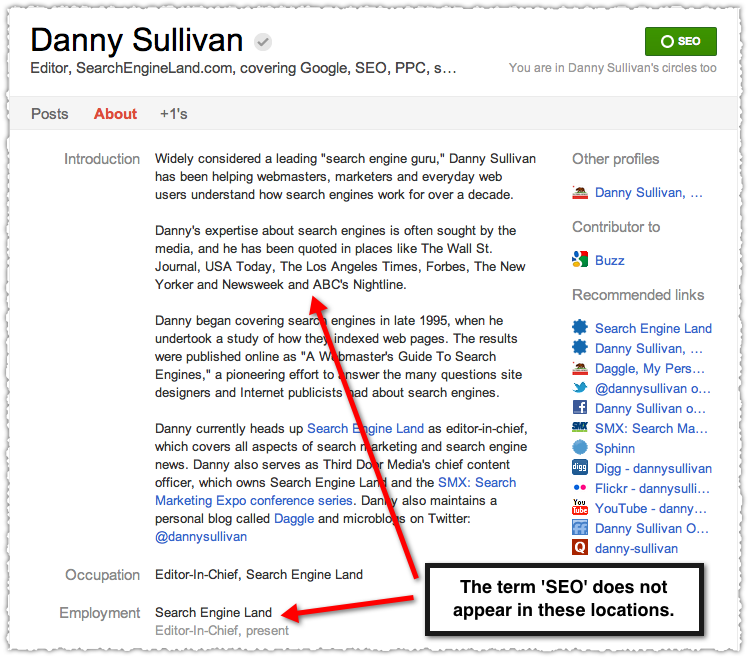
After the query match it’s all about who you have in your Circles. If you have more than six people in your Circles who also match the query then it comes down to a mixture of Circle count (heavily weighted), name verification (moderately weighted) and engagement (lightly weighted).
Occupation is not used. How do I know this? I’ve had Purple Jellyfish Farmer as my occupation for months. A search on this phrase returns no results.

Bragging Rights is also not used for People and pages search.
At present results also seem to favor People over Pages. But if you don’t have enough People to fill out these results Google backfills with Pages that have that query term in the name and a high Circle count.
Circle count is clearly important but some sort of engagement metric might be at play when the set of people returned is low. It’s difficult to say if or to what degree engagement plays a part right now.
Using a new Google+ account I was able to see ‘unbiased’ results.

While Jonathon has SEO in both Introduction and Employment (having it both places seems to help a lot) and enjoys a solid Circle count I find his inclusion here over others to be curious. These results point to a slight added weight on those who are verified. How you get verified is still a mystery to me. I’m hoping to figure this out in the very near future.
Google+ search results can change quickly. Here’s my search for SEO the day after my initial research.
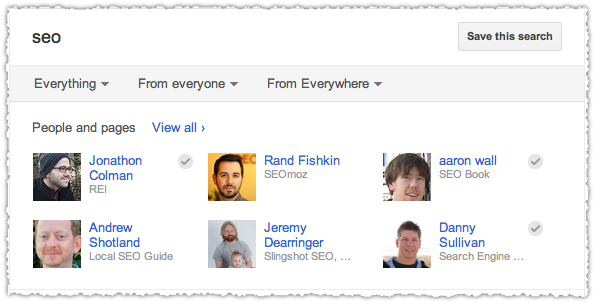
Danny Sullivan is now appearing instead of Bill Slawski. Why?
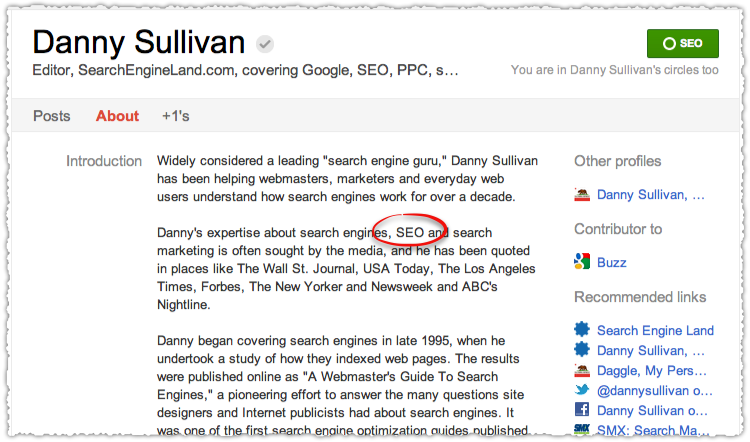
Yup. Including SEO in his Introduction now ensures that Danny will be returned for internal Google+ queries on SEO.
The Places lived section is also used for internal search purposes.
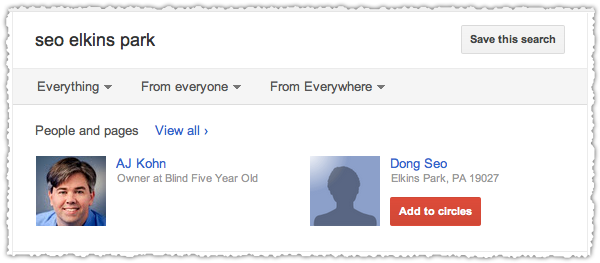
The problem here is that I haven’t lived in Elkins Park in the last two decades. And if users are looking for people and pages using Google+ then there will be a lot of false positives.
Google+ Search Spam
Clearly there’s also an invitation to spam the Places lived section. If I wanted to show up for searches in numerous cities I could just say I lived in all those places. In fact, there are a lot of areas ripe for spam right now.

Arpeet is ranked well up in a search for SEO. I don’t know Arpeet. He might be a fine SEO but I found it curious that he was ranked among some of the better known folks in the industry.

Clearly Arpeet is dropping every SEO related keyword in his Introduction but he’s also spammed Google+ by claiming his Other name is SEO.
Education can also be spammed.
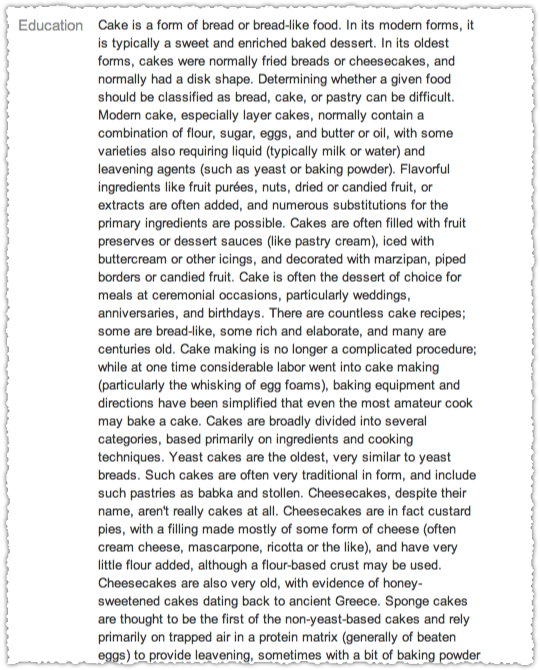
The Google+ spam cop (who is not Matt Cutts) will need to keep an eye on these and other methods of spam and over-optimization. Right now it seems way too easy.
Search+
Sorry but I am not going to use that silly name or acronym and instead will refer to the new integration of Google+ into search as Search+. While I will speak to the controversy surrounding this integration my focus will be on the implementation and what it means for SEO.
In a nutshell Search+ transforms your search results based on the connections, interactions and activity you have on Google+. It is the largest search personalization effort ever attempted by Google.
Search+ can be turned on and off using icons near the top right of the page.
![]()
This helps to address critics of the filter bubble phenomenon. You can set the default view by clicking the gear icon and selecting search settings.

Among other things on the page you can set your Personal results preference. This doesn’t mean that you won’t be able to access one or the other, it simply sets one as the default view for your search.
People and Pages
One of the bigger features of Search+ is the promotion of People and pages for certain topics.
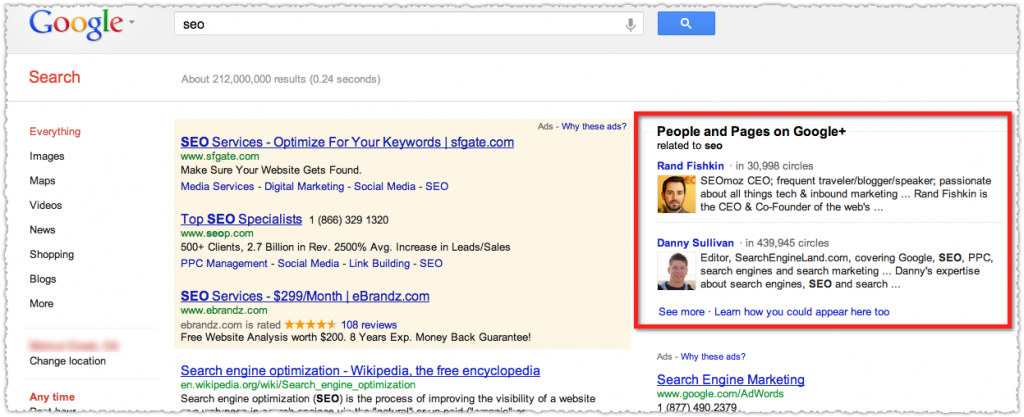
A search on SEO returns the profiles for Rand and Danny. The screen capture above is in a logged out session. If I were logged in I’d see whether these individuals were in my Circles. If they weren’t I’d be given the opportunity to add them right from the search result. Powerful stuff.
So, as it stands the rich seem poised to get richer.
Because Circle count is a primary factor in how these People and Pages are selected. It’s not the only thing as I’ll soon show you but it’s a large part of the equation.
But first, how useful is it to see People and Pages that are already in my Circles? Might it be more interesting to show People and Pages I don’t have in my Circles?
Danny and Rand might be the most relevant results but are they relevant if I’ve already ‘found’ them. If search is about discovery, then you’d think that the default should be to present people you don’t already know. This would actually make this feature interesting for a wider audience.
The assumption here is that all search is about discovery. But it’s not. Prior attempts at personalization provided Google with insight into how we use search to re-find content. This can be as simple as navigational search or as detailed as searching for a phrase in hopes of it returning ‘lost’ content.
While I believe that Search+ tries to address this intent I’m not sure the People and Pages section should be applied to that task. But I digress.
How are People and Pages selected?
First you can click the See more link and look at the list of people.

This is the same personalized list you get when doing an internal G+ search. But the order doesn’t map to the selections for People and Pages. In fact, we know that Danny wasn’t even optimized for SEO until just recently. Yet, during that time he was being presented in People and Pages for SEO.
So is it just flat out Circle count? No. Here are the People and Pages for Social Media.
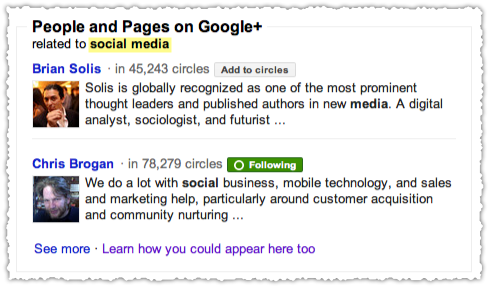
Makes sense right? But if I click See more I find that Robert Scoble is returned.

And we all know that more people have Robert in a Circle than Brian or Chris. In fact, he has more than them combined. So it’s not just about Circle count. Instead they feel like curated lists. Yet, that flies in the face of Google’s steadfast reliance on algorithms.
But it’s pretty clear that there is a list of people for each of these terms. Some lists are longer than others. For ‘blogger’ you can refresh and get a few different people.
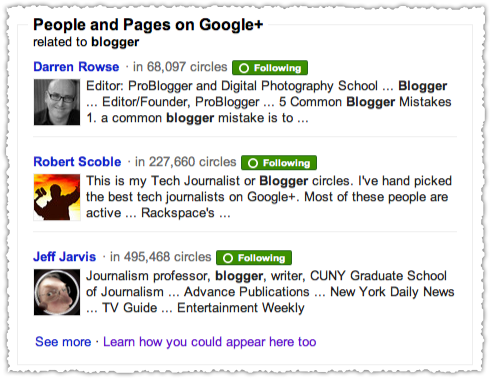

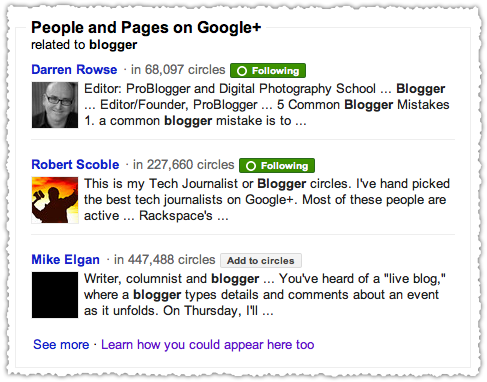
But try as I might, no matter how many times I refresh, only Rand and Danny are returned for SEO and Brian and Chris for Social Media. I’m left to conclude that People and Pages are defined, curated lists of people by topic. That means there’s nothing you can really do to optimize for these slots. Cue the torches and pitchforks.
[Update 1/25/12] The lists for both ‘seo’ and ‘social media’ have been expanded to include a handful of other people. Hit refresh a few times and you’ll see them cycle through the list for that topic.
Google+ Posts
Of course what we’re paying the most attention to is the actual Search+ results.
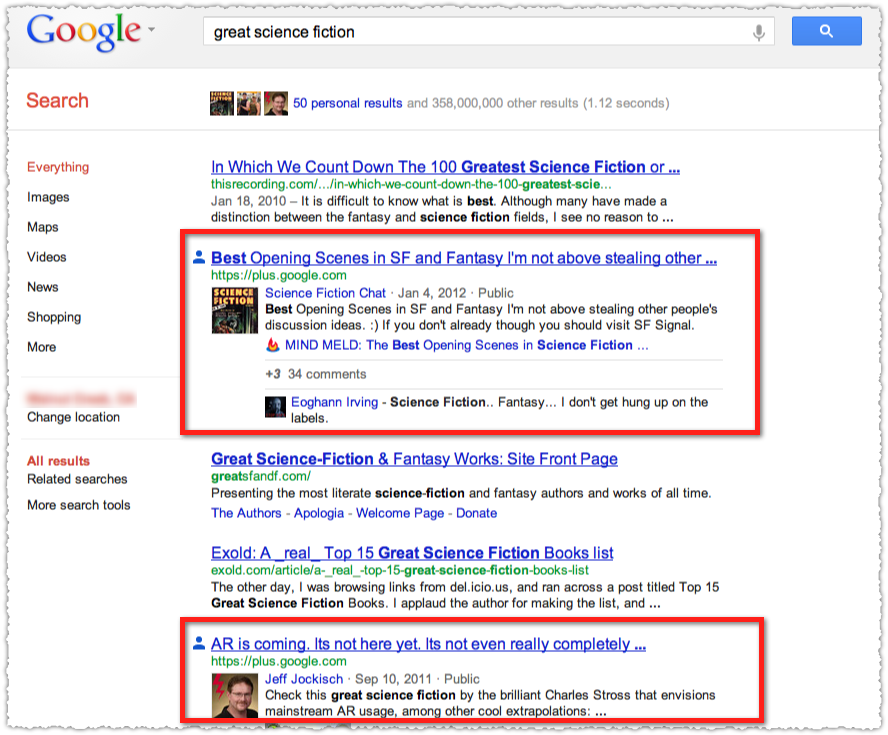
My search for great science fiction returns two personalized results in the 2nd and 5th position. Each of these posts contains a link to a site outside of Google+, as well as a those that lead directly to Google+. While a lot of attention is focused on the latter (Google is biased they scream!), I’m more interested in the former. Because here’s what the non-personalized version of this query returns.
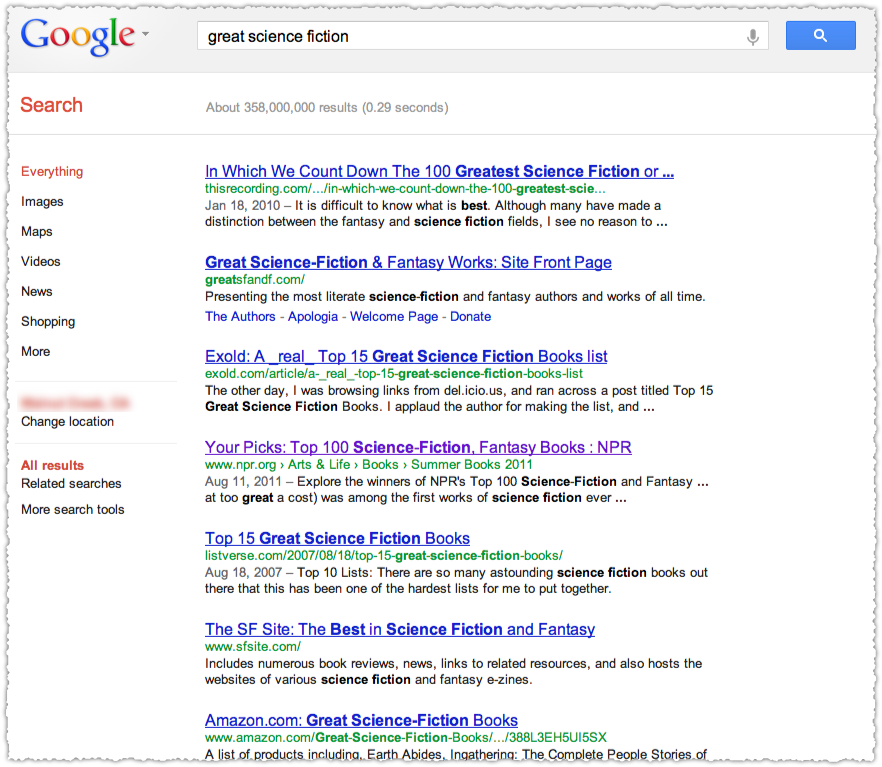
The two sites in my personalized results do not appear in these results. In fact, a site I’ve already visited (NPR) appear below these personalized results. To optimize for Search+ it is vital that sites produce relevant content that is easily shared. Of course the other element is the reach of those sharing that content. Those who are in more Circles and get more engagement will provide greater exposure for that content.
And if it tips and turns up in What’s hot, the reach for that item could be quite substantial. As an experiment, do a Google search for OCD and see if I am one of your personalized results.
This is where Ripples provides some insight. How is your content transmitted through the system? Which users helped to provide your content more reach? Identifying those people and engaging with them could help give your content more search visibility.
Search+ Algorithm
The current Search+ algorithm seems fairly rudimentary and is composed of only a few factors which can sometimes produce results that are less than desirable.
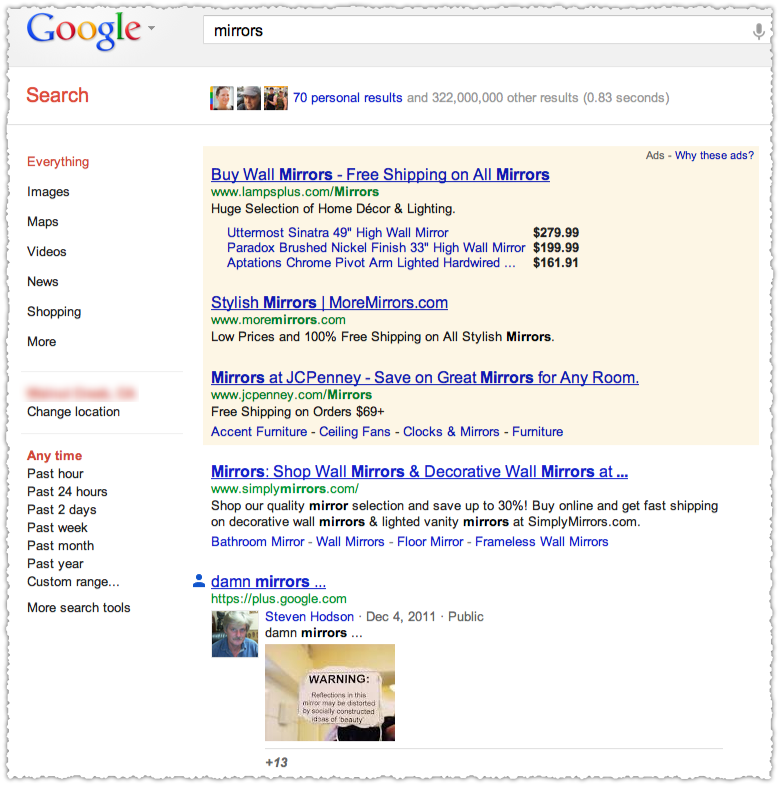
This humorous post by Steven Hodson won’t help me if I’m looking to purchase a mirror.
One of the over-riding factors in the Search+ algorithm is a simple text match on the query. There is no real determination of context or intent which can often produce these types of irrelevant results. This is a real achilles heel in the current implementation from my perspective.
This text match only occurs on those who you have in a Circle. This does limit the potential for spam since you’d hope you haven’t Circled a spammer. This also means that your Search+ results will, in large part, be a product of the number and type of people you Circle.
I have a fair amount of people Circled so my Search+ results can often look chaotic. Someone using Google+ just for family might have fewer personal results. Will they be more relevant? Well, think about posts on Google+ (or Facebook) from your own family and decide for yourself.
Where those results rank within Search+ results is another matter. It’s clear that engagement, both with that person and on that specific piece of content, is important. Content from people you engage with more often or content that is more popular overall will rank better.
When content was shared on Google+ also seems to be an influence with Google placing a moderate to heavy weight on recent content. We’re still in the beginning phase of the integration so I’m not sure exactly how much weight is being put here yet.
Anecdotally, I’ve also noticed that non-Public content seems to be given a lesser weight. I’ll look to validate this moving forward since this, in some ways, seems backward.
Looking forward I would think that Search+ would need to better understand context and intent to deliver the type of relevance most users are seeking. Don’t get me wrong, it works well sometimes but the signal to noise ratio can go sideways quickly, particularly if users are increasing their Google+ Circles and usage.
One way Google may think about solving these issues is by using and automatically filtering by Circle, particularly if they start to provide self-organizing Circle suggestions based on their acquisition of Katango. So instead of searching all your Circles Google may identify the query as being about photography and personalize those results based on your ‘Photographers’ Circle.
But we’re a long way off from that. For now it’s all pretty much spaghetti against the wall.
Google +1 Button
The prevalence of explicit social annotations has diminished since the introduction of Search+. The +1 button on search results is now only shown when you hover or rollover that result. The implication here is that the primary use of +1s is to deliver content into the G+ environment where it can then be used for Search+ personalization.
So instead of getting a bunch of visual cruft about how many people +1 this result and that result, they’ve decided to leverage all that data to deliver personalized results.
That doesn’t mean the +1 button isn’t important. It is. You want people to +1 your content so that it shows up on Google+ where it can drive traffic and engagement. The total number of +1s may be a social signal, but I’m unsure to what degree.

The +1 button number only reflects +1s from that URL. It does not take into account the +1s that occur on Google+ as a result of that initial +1. I sense that the latter metric might be more important to Google than the former.
Though if Google wanted to boost the adoption of +1 they could match Facebook and base this number on the +1s of that content from that URL and on Google+ as well as the total number of shares and comments. A higher number presented on the +1 button creates stronger social proof and may actually create additional +1s.
Either way, having the +1 button prominently available is vital for Google+ SEO optimization.
Google+ Social Snippets
I mentioned above that making content that is easily shared is vital. This means that you should make your +1 (and other) buttons easy to find and use. I’ve had great success with the floating share bar on this blog and on client installations.
Making them available is only half of the battle. How those snippets look is the next part of the optimization process. I have a detailed guide on how to optimize social snippets but will provide a few examples of why it’s important to get this right.
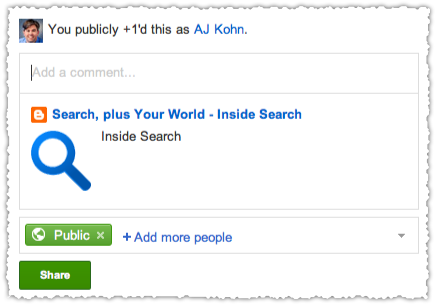
Google is actually one of the worst offenders when it comes to snippet optimization. They can get away with this but you can’t.
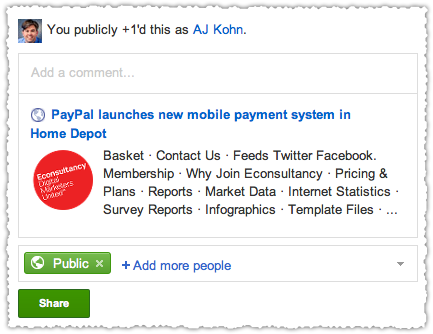
eConsultancy might not be getting as much social engagement on this item because of the poor snippet. The description here is clearly not related and the image, while branded, does nothing to tell me anything more about the story.
Optimizing your social snippets leads to more clicks, more comments and more shares. This is your content on the go and presented in an environment where people are scanning very quickly. Forget the 5 second test, this is the 2 second test.
This isn’t even that bad of a snippet since they do have their brand image. Worse is when you see a big RSS or Facebook icon. It happens. It happened to me before I decided I no longer wanted to shoot myself in the foot. So if it’s happening to you, get up and do something about it.
Google+ Content
It’s not just about content being shared on Google+. Content created on Google+ can also rank well under certain circumstances. This was true well before Search+ was launched. I innocently asked if people would know what I meant if I said ‘half measure and full measure’.
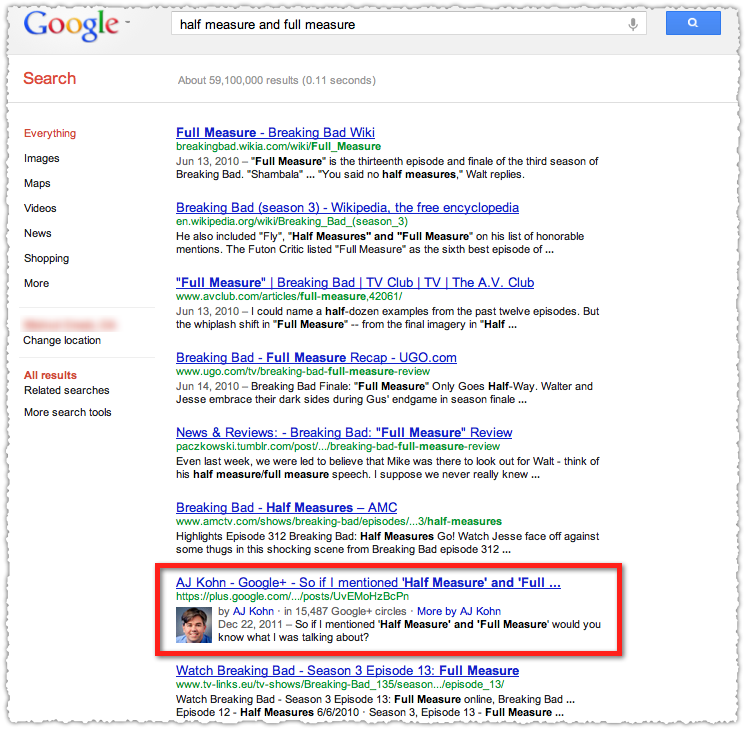
Sure enough, there I am as the 7th result for this query with an Authorship treatment that is likely to get me a fair amount more clicks than a normal 7th place result. This Google+ post has been as high as 4th. Now, it’s a long-tail query but make no mistake, you can create content on Google+ and get it to rank without personalization.
But now we’ll look at this same query with Search+ personalization turned on.

That post ranks 9th in personalized results but only because of the research I did recently for this very post which now ranks 2nd.
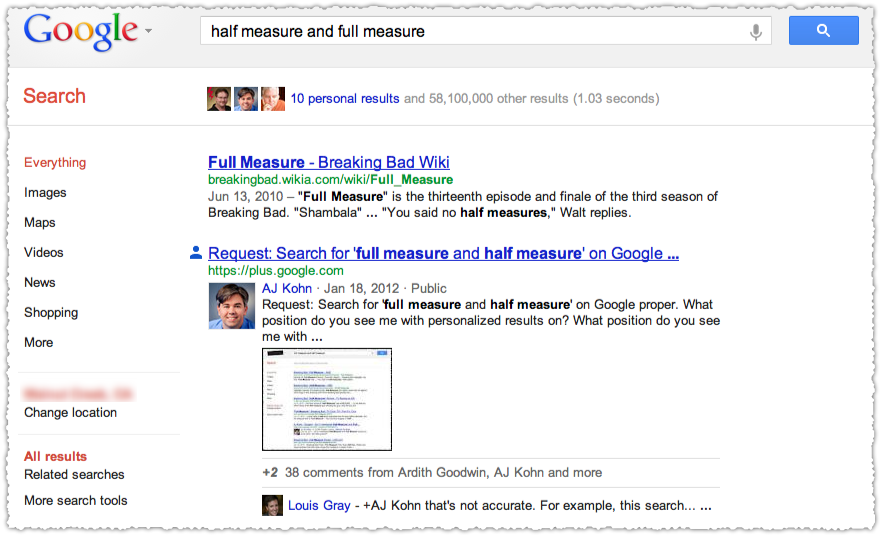
In fact, the speed in which Google+ posts are indexed is incredible, sometimes showing up within minutes of being published.
Google+ Formatting
Also notice that the Titles for Google+ posts are optimized in the personalized environment.

Compare that to what it looks like without personalization.

That prefix is pretty ugly from my point of view and reduces the chances that someone will click on that result. But let’s think about this for a moment.
Most users really just scan Titles to decide which result is most relevant or will satisfy their query intent. What would happen if users clicked on a Google+ result without knowing it was going to Google+?
That prefix is a very big and loud sign that tells users that the content is different. Sure, the result is in a SERP leading to Google+ and it has a fancy Authorship treatment but Google is also making it very clear where that click leads.
You should also format your Google+ posts to optimize for this presentation. That means creating a title for each post using bold formatting. You do this by placing a * at the beginning and end of what you want in bold (i.e – *This is the title*). When you share that post the * will disappear and the text between will be in bold (i.e. – This is the title).
Make your Google+ posts as readable as possible.
Google+ Brand Pages
You want to grab one of these and use it for, at a minimum, reputation management. The issue here is how much interaction and time you’ll need to dedicate to this social media outpost.
Managing a Facebook page (the right way) is actually a lot of work. A Google+ page would be just as much work, if not more. The major difference between the two is that Search+ can deliver a lot more people to your Google+ brand page.

A branded search for AT&T brings up the AT&T Google+ page. This only occurs for a very small select group of brands right now. The question brands have to ask is whether they want that much exposure? Conversations are right there on the search results. A lot of negative sentiment could then be just one click away. So if you’re not prepared to really be social, I’d be wary about this type of implementation.
Of course, brands can also show up as People and Pages suggestions.
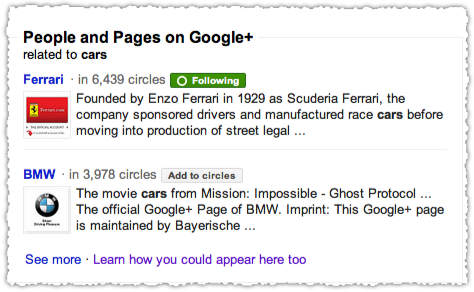
The actual conversations aren’t visible which is less scary in my view. I should note that Ferrari and BMW are the only two that show up for this query, further supporting the idea that these are curated lists.
I see this as a war of attention or perhaps a war of resources. How much time is a business willing to spend maintaining a social presence on both Facebook and Google? Surfacing the brand pages in search forces that issue.
Google+ Page Optimization
Optimizing your Page is far more difficult than your personal Profile. There are fewer fields to fill out, the current algorithm relies heavily on the Page Name and verification via rel=”publisher” is rather confusing.
The first thing to understand is that Pages do seem to be second class citizens from a search standpoint.
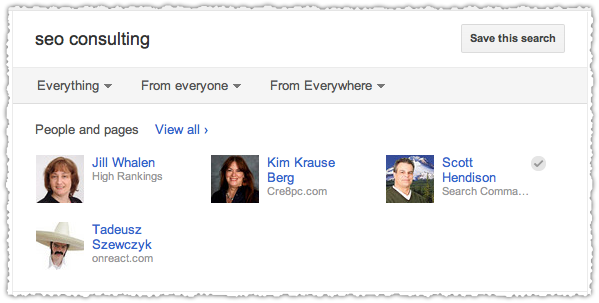
Here you can see that I don’t get a full set of People and pages results even though there are others that could qualify here (both People and Pages.) But in nearly every instance Pages are trumped by People.
That might not always be the case though so we’ll explore the current ordering by clicking View all.
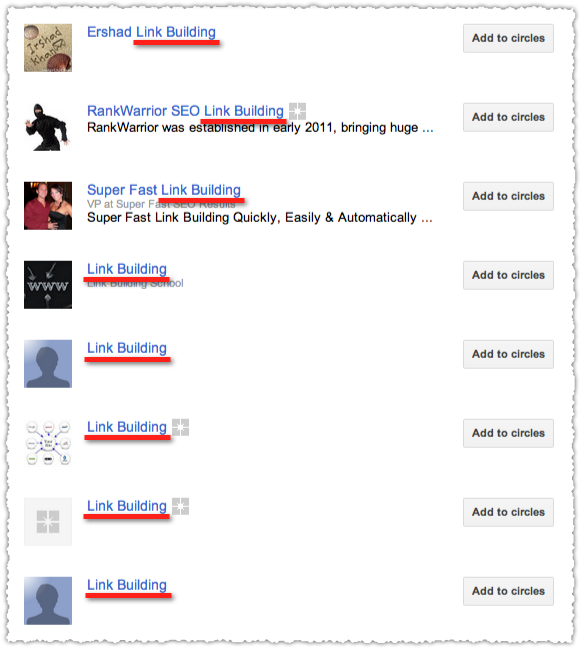
I’ve switched to a ‘link building’ query and am showing the second page of results after a host of people such as Eric Ward, Julie Joyce, Ivan Dimitrijević, Jim Boykin and other notables. These folks are all doing a bang-up job of optimizing for this term by having the keyword in their Introduction and often in their Employment as well.
But once I get past those in my Circles it really becomes about the Name field, even more so if it’s a Page. That’s not surprising since the only relevant fields for a Page are Name, Tagline and Introduction. While all of these fields do seem to be used the Name is given an enormous weight for Pages.
That doesn’t mean you should change your Page name to rank. That’s short-sighted and won’t help your brand. But you should be cognizant of this current limitation and ensure you fill out the Tag Line and Introduction thoroughly to boost your chances of being returned as this algorithm evolves.
The other reason not to change your name willy-nilly is that you will break your Page verification.
Rel=”Publisher”
A Google+ Page can and should be verified.
Verification badges helps users to confirm the authenticity of a profile or page. This way when you find a profile or page about a celebrity or popular business, you can be sure that the profile or page actually belongs to them.
Jon Ray got me pointed in the right direction about the mechanics and requirements of getting verified. The first step is linking your Page to your website. This is actually pretty straight-forward.

So far so good. But now you have to link back from your website to your Google+ Page.

Two things to understand here. First, the rel=”publisher” link must use the canonical version of your Google+ Page. The problem is that the canonical URL is never actually presented to users. Here’s what my Page URL looks like.
https://plus.google.com/u/0/b/105091680524136911230/105091680524136911230/about
But here’s what the link must look like.
https://plus.google.com/105091680524136911230
This isn’t a big deal for me but it certainly introduces a substantial area for user error.
More importantly, you should only place the rel=”publisher” link on your site’s home page. Yet, there are instructions on the Google+ Pages help page and within the badge generation code that tell you to place the rel=”publisher” link in the <head> section of your page. That essentially places the rel=”publisher” link on every page of your site.
If you implement it in this way and are also using rel=”author” (which you should be) then the Rich Snippets Testing Tool will give you this error and warning.

So instead you need to find a way to place the rel=”publisher” link only on your home page. Thankfully my sidebar is dynamic and I’m able to present a link just after my Blog Roll list that contains the appropriate mark-up.
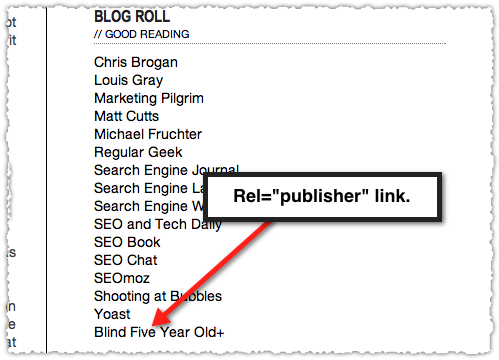
To confirm that you’ve set this up correctly you then drop your home page into the Rich Snippets Testing Tool.

This is what you want to see. You’ll want to test both your home page and a post page to make sure that you are verified appropriately from a publisher and author perspective.
Done right? Wrong.
The last step is to submit a Google+ Page verification request. But before you do make sure you meet all of the requirements.

1,000 people must Circle your Page to be eligible for verification. Not a trifling amount for a small business. While I still recommend implementing the rel=”publisher” mark-up, you’ll have to decide whether it’s worth the time and investment to get to that 1,000 mark.
Google+ Authorship
Google+ is an identity platform. One of the primary benefits is the ability to confirm authorship of your content.
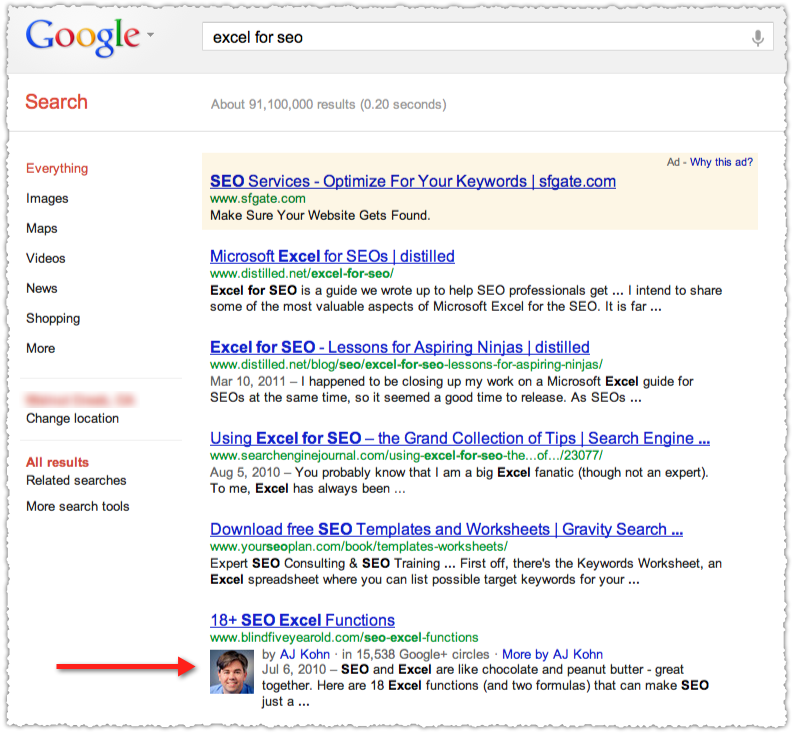
Authorship delivers a rich presentation that increases the click-through rate on that result. The image immediately draws the eye, just as other rich snippets do on search results, while the Circle count delivers additional confidence via social proof.
There is a clear short-term SEO benefit. But it’s the long-term benefit that might be more important. I’ll get to that a little later on.
If you’re interested in Authorship (and you should be) I have a Google Authorship guide to help you set it up.
Authorship Links
The Authorship presentation also has links to that author and a link to More by that author.

The author link just goes to the profile page but the More by link does something different.
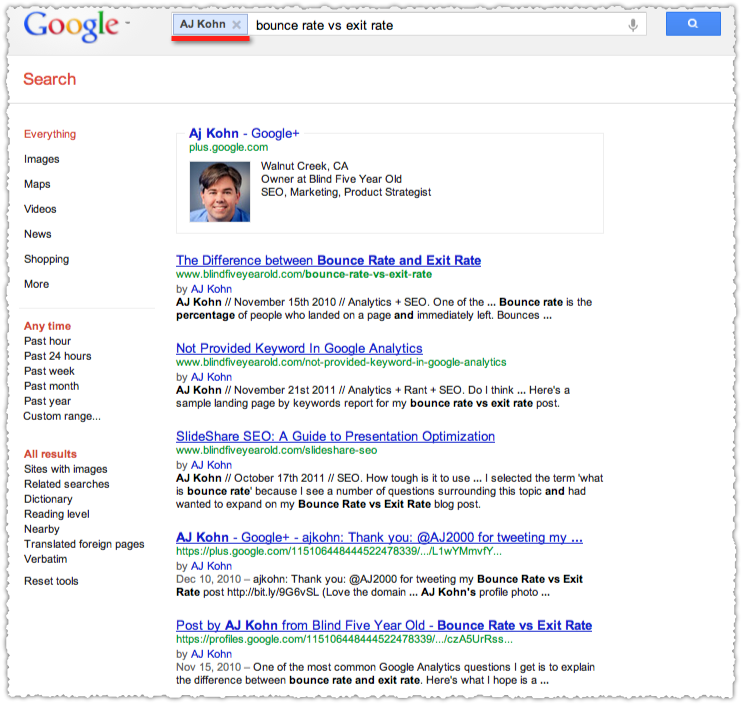
The More by link produces a compound search of sorts with your name and the keyword term. In this instance it does a nice job of pulling up some contextually relevant posts from my blog, a random Tweet that was archived by Buzz and my own post on Google+ that contains a link to the Bounce Rate vs Exit Rate post. Overall, I’m pretty pleased and it’s mildly compelling for users.
But it doesn’t always work that way.
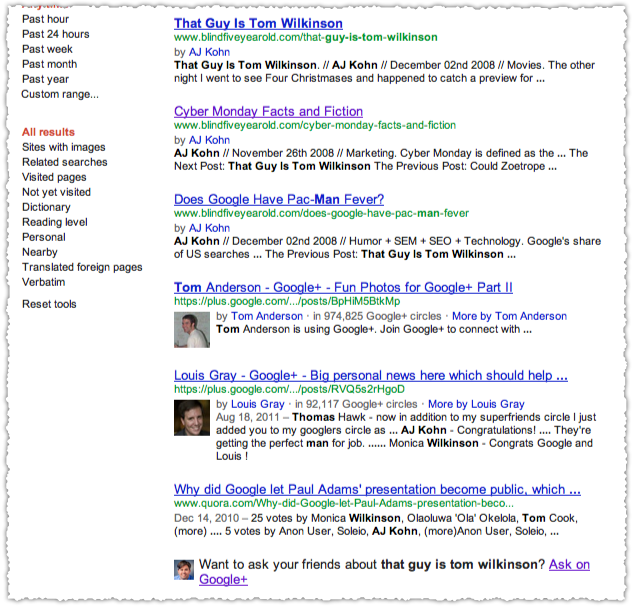
If you were to find my post on Tom Wilkinson and then click More by AJ Kohn the compound search would provide the above results.
The two other posts referenced from my blog are not related except for the fact that they were the previous and next post. The remaining results match on some or portions of the compound search but are not at all related. And more to the point, they are not authored by me.
This seems like a bug that should be fixed since the intent of that click is to see more by that author. More by author links do not deliver on the implied promise or fulfill query intent.
I’m doing all of this without Search+. Turn it on and in some ways this gets even worse.
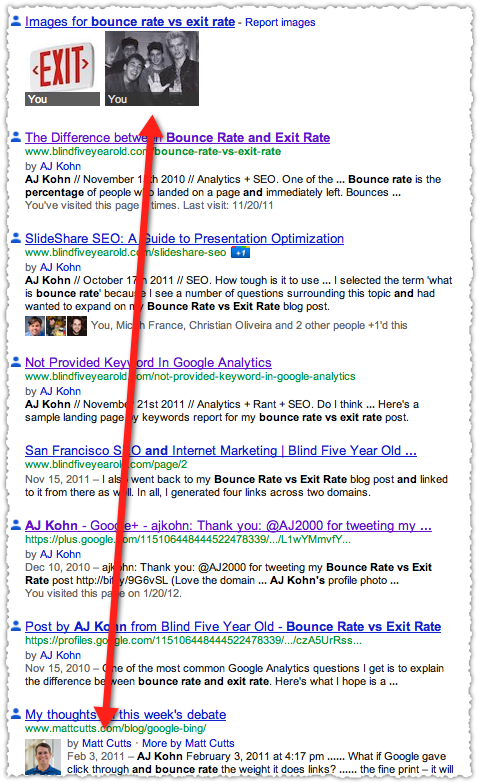
The photo with Billy Idol and the Beastie Boys is on another post and makes it here because of the previous and next text attached to that image. That’s not relevant but it is authored by me. But down below is a result from Matt Cutts. I like Matt and it’s not a bad thing to be associated with him but that post is not authored by me. Nor is the one below it (not pictured) which comes from Quora.
I am participating in conversations on these other sites, but that’s just not the same. I’m not thrilled with this but from a personal brand standpoint it might not be terrible. I stand behind the dialogs and conversations I have on other sites.
If I’m a publisher I’m probably freaking out because you could potentially be sending users to other destinations. But before we freak out lets think a bit more about intent.
Authorship and Intent
If I’m searching for ‘bounce rate vs exit rate’ my intent is to learn about the difference between these two metrics. The idea that a substantial number of users would click on the author name or More by link instead of the link that fulfills their query intent is, well, ludicrous.
Some users might click those links by accident. But what do you think happens then? If they click the author link and wind up on a profile, that doesn’t fulfill the query intent. The majority will likely return to the search result and click the correct link.
Click the More by link and the odds are that they’ll wind up at the same end destination link because it’s at the top and it’s the most relevant to your initial query intent.
The number of clicks that are lost to Google+, other sites or abandoned searches as a result of the Authorship implementation is extremely low when you layer on query intent. That tiny loss is more than made up for by the increase in visibility and click-through rate.
Google+ Influence
I’ve written a number of times about Google creating an influence metric that will impact how content is ranked within search. Google+ and Authorship are at the center of this effort. The long-term potential for AuthorRank is not a fantasy. We’re not talking about some Klout number that is essentially a reflection of activity. No, this would be a far more nuanced metric that would never be made public.
Not only will Google be looking at the quality of the content you produce, they’ll look at how it is received. Google+ allows Google to mine the engagement graph. Who shared your content? How many +1s did it receive? How many comments? How many shares? What was the sentiment of those comments? Were those comments valuable? Who made those comments? Were those comments from people influential on that topic?
Remember that Authorship is attached to content created on Google+ as well, both posts and comments. So your +1s and shares and comments are all being analyzed. The push for more engagement on Google+ is, in part, to expand the engagement graph and acquire more data so it can implement an AuthorRank algorithm with confidence.
Panda separated low-quality and high-quality sites. AuthorRank would do the same for people and their associated content. As the tidal wave of digital content roars in Google’s ears finding ways to sort the good from the bad quickly will be of increasing importance.
Content without Authorship could become a second-class citizen.
Circle Count
What can you do, aside from Authorship and creating great content, to increase your Google+ influence. First and foremost is to have a large following or Circle count.
Circle count isn’t as easily gamed on Google+ because of identity. While the pseudonym debate has gone silent I wouldn’t be surprised if Google didn’t assign a confidence score to each account. If you have a large following from accounts that Google doesn’t fully trust, your large Circle count will be less meaningful.
Obtaining a high Circle count means sharing and creating a lot of great material. One personal tip I can share is that your content doesn’t need to be on just one topic. If you look at my Google+ stream I’m all over the map. It’s essentially a look at what I come across and am thinking about from day to day.
That means you’ll get what I feel are the best articles on SEO, UX and other professional disciplines as well as inspirational images and a healthy does of LOLcats.
What that really comes down to is sharing more of yourself. Be human.
Engagement
I am sure that some people will say they do all that but no one engages with them. The truth is, this isn’t easy and it takes a lot of work on your part to make it happen. You can’t just post and think the world will engage with you. I see far too many experts claiming that Google+ is a ghost town because of this phenomenon. I don’t often say this but, those people are doing it wrong.
If you’re in the 1% of Internet celebrity then engagement will follow you from platform to platform. Robert Scoble, Ben Parr, MG Siegler, Danny Sullivan, Thomas Hawk are established and will see engagement no matter where they go. They’ve put in an enormous amount of time and effort to get there.
The 99% of us left have to do the same and earn engagement. So how do you do that? There’s no real formula but here are my personal observations and tips.
Post to Public. By not doing so you limit yourself and the ability for others to find you and your content. This means you should be aware of what you’re posting. You can be personal but you should have boundaries.
Respond to engagement. If someone +1s your post go and Circle them if you haven’t already. If they comment, reply to that comment using their @name. If someone shares your content go and +1 that share and add a thank you comment if appropriate.
Flag people down. Use the @name function wisely to reference people who might have a view on that content or to which you want a response. Do not over do this or you will piss people off. But done right you can actually bring the right people into a great debate.
Create conversation. Comments meant to engage should not be of the ‘great post’ variety but should be valuable. Thoughtful comments that bring up issues and add value are more likely to get a response.
Cultivate engagement. Keep track of the people who engage with your content most frequently. Put them in a Circle and you can share directly with them, kick-starting engagement on your post and increasing the probability of more engagement.
Circle people. Circle people in your area(s) of expertise. You’re not looking for them to follow you back (though some will) but instead you’re looking to interact with the content they produce. It’s that engagement that will translate into more people Circling you.
Monitor real time searches. You can quickly find, monitor and engage with specific content by searching by keyword and jumping into the real time stream of results. Yes, real time can be useful in this instance.

Find some searches that work for you and save them so you can access them again and again. This is the way I was able to monitor and respond to those who were sharing this guide.
Google+ SEO Best Practices
Here’s a quick checklist of 9 items critical to your Google+ SEO success.
Optimize your Google+ Profile
Fill out your Introduction, Employment, Education and Places lived understanding that the text in these sections is used for Google+ search. If you want to be returned for the term ‘SEO’ you need to have that term in one of these fields.
Placing the term in two or more fields seems to deliver some added benefit. Do it if it makes sense but don’t go overboard.
Get Verified
A verified name with that small checkmark icon seems to have some influence on Google+ search. When I figure out exactly how to make this happen I’ll let you know.
Confirm Authorship
Google+ is an identity platform that allows you to claim Authorship of your content. Doing so delivers a type of rich snippet in search results that will increase the visibility and click-through rate on your content today and may put you in the catbird’s seat when Google implements AuthorRank.
Use the +1 Button
Put the +1 button on your site prominently so users can deliver your content to Google+. Not only will this result in traffic to your site, it allows Google to understand how people are engaging with your content.
Optimize Social Snippets
It’s not enough to just create content and have the +1 button on your site. Optimize your social snippet to ensure you’re getting the most engagement out of your content.
Create Great Content
Put this in the ‘no duh’ category, but really, create great content. It’s not enough on its own but everything gets easier if you do this.
Share Great Content
Great content takes time so you won’t always be sharing your content. Instead, share the great content of others. Make your Google+ feed valuable and interesting and you’ll be rewarded.
Format Google+ Posts
Just putting a URL as your Google+ post won’t cut it. Create a bold title for each of your (longer) posts. Not only is this easier to read it’s what Google will use as the browser Title on Search+.
You should also start to use hashtags, sparingly, to ensure your posts are aggregated appropriately.
Use Google+
Really use Google+. Using it for the express purpose of SEO won’t be successful. Do or do not. There is no try.
The Next Post: What Is SEO?
The Previous Post: What I Learned in 2011

98 trackbacks/pingbacks
Comments About Google+ SEO
// 136 comments so far.
Jonathon Colman // January 20th 2012
Wow, fantastic, comprehensive post, AJ. I agree – it is odd that I appear there alongside folks who are arguable industry leaders. I mean, I’m pretty nifty and all, but I’ve still got a ways to go. Heck, I wasn’t even aware that I was “ranked” (if that’s the right word, and it’s probably not) so highly for a Google+ search on [SEO] until your crowd-sourcing post. Some SEO I am! 😉
Something else you might want to look into: the auto-suggest search results you see immediately in the drop-down as you’re typing in the search field at the top of the screen. Look at the results as you type in a search for [SEO] – none of the people listed are relevant. But under pages I see SEOmoz, which is great. I wonder why the algorithm seems to work so differently for auto-suggest?
Again – great post and fascinating work!
AJ Kohn // January 20th 2012
Thank you very much Jonathon. I’m glad you understand that I wasn’t denigrating your contribution to the industry! Clearly you’re a Google+ SEO ninja and you didn’t even know it.
I actually had the Google+ Instant results in a prior version but dropped it (for now). I plan to add that and image search to the guide in the next few days. Because you’re right about Google+ Instant, it’s got a funky algorithm, particularly for people.
Greg Shuey // January 20th 2012
All I can say is DANG!!! Your post just made my head hurt and now I have a lot to do in the morning. Thank you so much for putting this together.
AJ Kohn // January 20th 2012
Thanks Greg. It is … long and dense and at times takes some detours but hopefully each section delivers instruction, insight or provokes thought. Let me know if you have any ideas on how to improve the guide.
Jon Cooper // January 20th 2012
Jonathan – how do you become verified? Wondering this for my page (Point Blank SEO) that was shown in one of the pics, because I’m guessing that will increase CTR, # of people in circles, and whether or not it shows up in the SERPs for certain keywords.
AJ – this defines great content. A++ for the highlights too – I really needed those!
Here’s my question. When do you think the top right box in the SERPs that displays relevant people & pages (i.e. for SEO, Rand & Danny show up) will expand to other results? I’m really curious about this more than anything else on the subject of Google+. And do you think they’ll turn to an algorithm, or will they keep it a curated list?
Also, I think they’re putting more weight on Pages than people. As I said, my page, Point Blank SEO, is showing up high for the search “SEO”, and I only have roughly 700 in my circles, yet other SEOs who fully optimize their profile for the term “SEO” and have thousands in their circles show up after my page.
Interested to hear your thoughts on my questions. Again, great job AJ!
AJ Kohn // January 20th 2012
Thanks for the comments Jon and I’m glad the highlighting helps. In really long pieces like this I think it’s critical to give those types of cues to readers. I may even go back and highlight a few more passages.
As for the People and Pages expansion question. I think it depends on what type of response they see from users. If it’s positive, I would anticipate that expanding to additional keywords would be coupled with a true algorithm. Google knows that a curated list of individuals isn’t a long-term scalable strategy. But doing it this way gives them the ability to measure user behavior. The last ‘hand-picked’ list Google used was on the Google Health Onebox which was then revamped to simply use the NIH. I have to believe an algorithm will be developed if the People and Pages feature is going to persist.
For Google+ search I still see them favoring People over Pages when the set of People who match on that query is high. So a lot of this has to do with who is in your Circles. You can see a little of this through the crowdsourced research done on Google+ for this guide. Most didn’t have Pages, though you SEO Book and SEOmoz sneak in a few times.
Pages do seem to have a slightly different algorithm, which makes sense since there is less information about them. You’ve got the Name, Introduction, Circle and +1 count and maybe that tagline. Though it’s not in the guide (yet), I believe that Name and Circle/+1 Count are the more important factors here. It’s why you, SEO Book, Dejan SEO and SEOmoz perform so well.
When you search for ‘link building’ I see a lot of People who are optimized for that term. Eric Ward, Julie Joyce, Jim Boykin, Ivan Dimitrijević, Wiep Knol etc. The first Page I get is for one named Link Building. In fact every Page on my list has the term in the Name. So if you were Point Blank Link Building I think you’d be dominating that term. But without it in your Name. Not so much.
The algorithms for Google+ search are still in their infancy. I expect we’ll see people over-optimizing here and the algorithm getting more and more refined over time.
Let me know if you do any tests. I’d appreciate feedback so the guide can improve and evolve over time. Thanks again for the comments and great questions.
Jon Cooper // January 20th 2012
Also, thought I’d add, Point Blank SEO mentions the term “link building” in the slogan once and introduction 5-6 times, yet doesn’t show up in the top 20 for a search for “link building”, yet it shows up (as I said) highly for SEO, which isn’t mentioned in the slogan, and in the introduction 4 times (3 of which when I say “Point Blank SEO”).
Not trying to be self promotional, just curious on your thoughts for this! You really got me thinking on search within Google+.
iwebsquare // January 21st 2012
It’s not a guide, i call it bible for Google+ ! As we say, Google+ has just come and the spamming will be started as you given a great example of it and other information that how it can have a impact on the search results of G+.
delizard web design // January 21st 2012
wow! very great article, thanks!
A little question: in the next future, if i will not use Google+, also my website ranking will decrease his position in serp, or my website is indipendent by my Google+ account activity?
thanks! bye!
Ivan Dimitrijevic // January 21st 2012
Hi AJ Kohn. :]
I have to admit I am a big fan of your work and hard resource pages, specially for Google+ SEO related stuff. This is really the ultimate Google+ SEO guide with some fantastic tips and some serious testing and thinking behind it.
For testing purpose I am using Google Chrome for logged in personal results and for logged out non personalized results I am using US non personalized search profile from SEOmoz bar for Firefox. I think that’s better than Google Chrome Incognito because of geo-location included on incognito search. On that way I can search inside Google+ and see exactly what’s going on. But, I am not sure 100%.
I’ve done a lot SEO related test searches on Google+ (personalized and non-personalized) in the last week for more specific SEO related terms and web design related terms like:
seo consulting, seo consultant, seo consultants, google+ seo, google+ seo consulting, google+ seo consultant, seo link building, web design studio, seo design, seo consulting services…
https://plus.google.com/s/seo consulting/people
https://plus.google.com/s/seo consultants/people
https://plus.google.com/s/google+ seo/people
and so on…
And I think I am ranking well (top 10) on Google+ for all these terms but I am not sure about my non-personalized results because of specific geo-location and for test purpose you can run more tests for more specific seo related terms and we can see does specific geo location can affect our results from Google+.
Plus, I’ve done some testing on Google, for my friend Mihailo Radicevic, for street photography non-personalized US and I see 3 social results on people and pages section and I found that very interesting. And results are not the same every time.
Probably I will post some screen shots later today, or tomorrow, I am not sure, and I will link here my Google+ posts with screen shots just to see if we can conclude something useful. :]
And OFC I think your quick checklist of 9 items critical to your Google+ SEO success is real Google+ SEO best practices at this moment. :]
AJ Kohn // January 21st 2012
Ivan, many thanks for the kind words and interesting searches. You’re definitely showing high up in my view all section for those terms. But you only show up in the default view for one of those three. In fact, in two of those instances I am only getting four results out of six.
This is actually quite interesting since it seems to indicate that there’s some limiter in terms of what qualifies for that presentation and Google is not backfilling with Pages. I’ll have to poke at this some more and update the guide accordingly.
Stephen Dickson // January 21st 2012
So is the reason ‘Brand Pages’ don’t search so well because they don’t have thing’s like employment and a few others that personal accounts have. So that would or could be the reason they don’t search so well? Sounds logical to me if Goog are only looking at those points. And will Google change that????
AJ Kohn // January 21st 2012
Yes and no Stephen. There is less to go on for Pages but it’s really Google applying a sorting weight to those results. So Google could change that and have Pages show up more often. I don’t see that happening soon though. I think the Page implementation has to change materially before Google is confident that it’ll produce positive reaction.
Paul Gailey // January 21st 2012
thud! – that noise was my jaw dropping on the table. Staggering post sir, thanks.
Do you place any importance on a users +1’s being public or not? I assume it makes no difference to Google as a signal but I do note that many choose to conceal it (can’t remember the default setting) and anecdotally I detect a reticence to +1 content that is not related the users domain, which strikes me as parsimonious. Where I am more perturbed is noticing publishers setting the +1 button to plus the root domain instead of the page url when the button is placed within the body content, and not in the fat footers/sidebar. Spam never dies, it just seems to mutate.
AJ Kohn // January 22nd 2012
Paul,
Thanks for the kind words. You bring up an interesting point about the impact of +1s being on Public versus Private posts. I think you’re right though, Google probably doesn’t care, but clearly you’ll have less opportunity for engagement (whether that’s a +1, share or comment) if you’re continually posting to a specific Circle.
The way people use the +1 button varies widely. For instance, many feel uncomfortable +1ing a post that is negative or deals with something tragic because they feel like they’re saying they like that content. Others, like me, use it to connote approval but also to draw attention to something important. The inent of a +1 is still murky just as a Facebook Like has multiple intents.
And sadly some sites are trying to pad Likes and +1 numbers by having it all point to the domain or home page instead of having it on the specific URL. That’s a short-sighted strategy but, sadly, that doesn’t stop people from trying it.
Ronen // January 21st 2012
Great article. Thank you
Got a question: How do you “confirm authorship”?
AJ Kohn // January 22nd 2012
Ronen,
I’ve created a guide to Google Authorship that should help you through the process. Let me know if you have any questions or problems.
KJ D'Costa // January 21st 2012
This is the most concise breakdown of Google+ that I’ve read to date. However, as eCommerce site owner, I would love to get details like this for the Google brand pages. Hint hint…
AJ Kohn // January 22nd 2012
KJ,
Thank you and I’m working on an update to the guide that will speak to Google+ Pages and how they’re exposed and ranking in Google+ and Search+ results. So stay tuned.
Aaron // January 22nd 2012
Fantastic article AJ! This is by far the most thorough analysis of G+ that I have seen so far.
When it comes to trying to get more people to circle you, I was wondering what you think about the strategy of circling lots of relevant people first with the hope that some reasonably amount of the people will follow you back? (Obviously, this needs to be combined with the other elements that you mentioned above and not to the point of spam like so many people do on Twitter)
Is there a maximum amount of people (or ration) that G+ will let you circle? Are there any draw backs to this?
I’m subscribing to you blog and I look forward to reading more of your content.
Thanks,
Aaron
AJ Kohn // January 22nd 2012
Aaron,
Thank you for your kind words as well as the questions. Circling people is a good idea (I should mention that in the guide). It’s less about hoping that people Circle you back, though some might, but more about your ability to see the content those people are producing and joining those conversations.
However, before you Circle a lot of people I’d recommend filling up your own feed with good content. It’s similar to Twitter in this regard. You don’t want to create an account and immediately follow a whole bunch of people. Because when they look at your feed to see if you’re ‘worthy’ of following (or Circling) you don’t want them looking at an empty feed.
The Google+ Help Center shows that there is a 5,000 limit across all Circles along with a daily addition limit. I swear the 5,000 limit has been revised but, perhaps not. You shouldn’t be getting to that count anytime soon anyway though.
Thanks again for commenting and for becoming a subscriber.
Stephen Dickson // January 22nd 2012
The best way to do that Aaron is interact with people. If they like what they see you’ll get out there.
Jessica // January 22nd 2012
What an amazing synopsis! Do you know if search results for Google+ have anything to do with what browser you use? I noticed that I got 100 more personal results when I searched on Firefox (my main browser) than why I conducted the same search on Safari (which I don’t use as often). Would love to know your thoughts!
AJ Kohn // January 23rd 2012
Jessica,
That’s an interesting question. Browser may be one of the ways that Google alters search results. They’d chalk this up to context and not personalization. It’s likely more akin to language, geography and query refinement. So the bottom line answer is I’m not sure and that makes me curious to investigate.
Karen Goodman // January 22nd 2012
Thanks for the comprehensive guide. You definitely convinced me that I need to spend more time connecting with people on G+. I haven’t put much effort into finding people to follow or getting into more circles.
I did just update my About page based on your advice. And I posted my first update with a title in bold.
I really wish that I could push/read updates from Seesmic like I can do with Twitter and Facebook. I would still post links by going directly to G+, but it would definitely make engagement happen more often.
AJ Kohn // January 23rd 2012
Karen,
Thank you for the kind words and I’m glad you’re doing more with Google+. I too have wanted the ability to ‘syndicate’ from other sources to Google+. It was one of the prime ways I used FriendFeed before moving on to Google+. It’s a double-edged sword though, the ease of that type of syndication might water down the content and conversation. The high-bar for content creation (actively pushing it) is intentional and while annoying at times, may be what’s best for the platform.
Yanik Silver Fan // January 23rd 2012
Google Plus is the real deal now. There is no ignoring it.
Incredible wake up post, if we consider ourselves serious internet marketers, we better start cracking at this.
Confirming authorship seems to be a pain in the ass… but the harder it is the less likely the competition is to doing/knowing about it 😉
AJ Kohn // January 23rd 2012
Yes Yanik, confirming Authorship isn’t the easiest thing in the world and not every will get the treatment even when they do implement it correctly. So if you can pull it off you’ll probably be ahead of your competition. Worse though is if you don’t but your competition does.
Brian Turner // January 23rd 2012
Great post, but a slightly tangential question – the floating likes bar on the left of page for Tweets, +1, FB and LinkedIn – which plugin is that, please?
AJ Kohn // January 23rd 2012
Sure Brian. It’s a highly hacked version of the Smart Sharing plugin which I believe is now offline. It does the job for me now but it took a lot of work to get it this way. I’ll have to find a better version or do my own when I relaunch the site with responsive web design.
Chris Denny // January 23rd 2012
Probably the best article I have read about Google+. Also very much a linkbait/twitterbait piece as I have retweeted and put on my Delicious.
We have a small team and are going to make sure that we all optimise our profiles. Probably going to offer everyone an incentive for getting to 1000+ in their circles – afternoon off work down the pub the likely prize.
Funnily enough, if I change profession a Purple Jellyfish Farmer job sounds rather interesting!
AJ Kohn // January 23rd 2012
Thank you Chris and just make sure you’re focusing on quality as you build those Circles.
And yes, perhaps I’ll be a Purple Jellyfish Farmer when I retire!
Clifford Blodgett // January 23rd 2012
This is amazing I have been sharing it with all my internet friends, and even some friends I see in person. I signed up to be verified by Google Authorship over 2 months ago and it seems to be a little back logged.
AJ Kohn // January 23rd 2012
Thank you Clifford. Regarding Authorship, it can take a while and Google does reserve the right not to apply the treatment (even when implemented correctly) for a handful of reasons. Keep checking to make sure your pages validate via the Rich Snippets Testing Tool and fill out the form if you haven’t already. Sometimes poking the bear works.
Keith // January 23rd 2012
Interesting post about the occupation and profile search rankings, definitely makes it worthwhile to optimize your profile. Makes Google+ completely different than Facebook from an SEO perspective.
Adam Sherk // January 23rd 2012
AJ, this is indeed a “great post” comment of the non-engaging variety, but wanted to say thanks for putting together a such a solid overview. I even stuck through all the way to the end. 🙂
On a related note, I agree with Jon the yellow highlights are helpful in longer pieces like this.
Wissam Dandan // January 23rd 2012
Hi AJ
My company has a ” static page” (wordpress) and no blogroll so instead I added this code (http://pastebin.com/0snVV7kv) to verify our Google+ Page.
The code works for WordPress sites. What it basically does is checks if it is the homepage —> it will show the badge with a rel=publisher if not it will show the badge without rel= publisher
Notes: Badge used is 16px x 16px –> change this https://ssl.gstatic.com/images/icons/gplus-16.png to the badge you wanna use
Cheers and great job AJ!
AJ Kohn // January 23rd 2012
Thank you Wissam for providing an alternate way to properly implement rel=”publisher” and use the badge at the same time. I’m sure many will benefit from this.
David Gelb // January 24th 2012
Hi Aj
Good article.
How do you think other social networks will respond to this, especially Facebook. The link worth SEO and Google + is a real threat to them it seems? Do you think companies will shy away form Facebook now and use Google + at the centre of the digital strategy?
Quentin Aisbett // January 24th 2012
Fantastic AJ! Thanks for the thorough explanations.
Ronen // January 24th 2012
Thank you, AJ
I will take a look at the Authorship article
Keep on the good job
Dave Doolin // January 24th 2012
Thanks for writing this up. I know it had to have taken hours and hours.
The whole Google+ thing, in many respects, removes the incentive I’ve had to produce content for the web. The attraction for a “non-social” search is that I could spend time I would rather spend socializing on, well, socializing, or on building quality content. Now, I either take time from content, or give up more in-person socializing.
I suspect one of the side effects of this will be to reduce the diversity as attention is increasingly focused on influencers.
In any case, the message seems clear: interact on Google+, or watch your presence in Google search results evaporate. I hope I have this wrong.
AJ Kohn // January 25th 2012
Dave,
Thanks for your comment. I don’t think this reduces the need for quality content. In fact, I think it’s more important with Google+. You need content that is ‘portable’. That people want to and can easily share.
The second part of the equation is your engagement and interaction on Google+. That can certainly help as well. If you are a trusted curator of sorts in your niche on Google+ then you may gain the ability to rank well for your own content in that niche or through Google+ ‘native’ content. Not to mention the reach your shared content will have via a larger Circle.
At a minimum I believe confirming Authorship is critical moving forward. Google wants to know who you are and what you produce. The level of interaction is the wildcard at this point. I think it will help but I’m not sure you’ll be penalized for not being social enough. It’s a nuanced topic.
Reinier van der Eeze // January 25th 2012
Excellent article. I am still trying to find this Google Plus thing out but this article should help me in the good direction. Thanks for that.
I am wondering though if only Google + results from within your contacts will show in the Normal Google results?
AJ Kohn // January 25th 2012
Reinier,
Thanks for your comment. Search+ results will only be pulled from those you have in your Circles. At least right now. Google could conceivably pull content via FoaF (Friend of a Friend) but that usually seems to freak people out.
MJ Hughes // January 25th 2012
Wow thank you very much AJ – a really comprehensive guide to Google+ which I am sure many people (including myself) will be using as a Bible for the next few weeks and probably months! I was sceptical about Google+ initially, however it does seem primed to take over the world as we know it… SEOs who ignore this super power in the making will do so at their peril.
One thing I’m not getting is the Google+ pages on the right hand side of normal Google searches… I’ll be keeping an eye out for them.
AJ Kohn // January 25th 2012
MJ,
Thanks for your kind words and comment. The People and Pages on the right hand side of Search+ results only appear for a handful of root topic terms at this point. You won’t seem them for mid-tail or long-tail terms.
Jay Gao // January 25th 2012
Thanks for this great insight and tips about Google+. The tips are very practical and useful, and on the other hand your post gives an overview of the ranking algo in Search+. It feels like the early days of search engines, when keyword stuffing dominated the SERPs. By comparing the two, we could probably regard engagement and circles in Google+ as backlinks in standard SEO, which will soon be the dominating factors in the algo.
AJ Kohn // January 25th 2012
Jay,
Thanks and I think you’re right. This is reminiscent of the early days of search engines. The algorithms here are very rudimentary right now. I don’t expect them to be that way for very long though.
And the engagement graph is certainly an area I believe is of great importance to Google. What else are the people they acquired from PostRank and Social Grapple doing?
Leslie // January 25th 2012
Thanks for this detailed post. I’m weary of new social media efforts because, like you said, they are a lot of work. Going over the nuances of optimization have confirmed for me that it’s time to invest.
I wonder, though, how all this will fit in (if at all) with markets that aren’t so socially engaged. Consider that seo’s and link builders are all over the Internet, active in social sphere’s and posting content like crazy. But what about, the travel industry for example? There doesn’t seem to be much of a presence there. Is Google going to leave those results be until there is true relevance in Google+ to be added to the search results regarding those terms? I do a lot of work for travel industry guys and it just seems to me that there isn’t a market for the to create a Google+ profile. Who’s going to interact with them? Are we going to be posting content to an empty abyss for a while?
Just some thoughts. Thanks again.
AJ Kohn // January 25th 2012
Leslie,
Thanks for your comment! You’re right that someone like me or my ilk are not the norm. But even those who aren’t going to have the time or resources to dedicate to engagement on G+ can optimize their content to be distributed through the platform.
Content that is valuable and portable will find it’s way into G+. It’s the ability to get that content into as many Circles as possible, to the people who have a large Circle following or are highly engaged in that vertical. It’s less about how many people you have Circling you versus the reach of those who share your content on G+.
I’ve only had one coffee thus far this morning, so if this isn’t clear let me know and I’ll clarify.
Doerman Photography // January 25th 2012
Seriously thank you for this. Absolutely wonderful and in-depth. I knew a bit, but didn’t know some – especially the authorship information.
I have a question, though. As far as circle numbers, is there a difference in authority for users who have far more followers than following others? For example, if I have 10k followers and I am only following 2k, are my actions weighted more than if I had 6k followers and 6k people I’m following?
AJ Kohn // January 25th 2012
I doubt that Google is using Twitter-like metrics of Followers to Following. It’s not something I’d recommend paying attention to and any efforts to create the appearance that you have a ‘better ratio’ may be a tip off that your account is unnatural. So, just Circle folks for the right reasons, don’t do any Circleback schemes and let your content and engagement drive your own Circle count.
Vincent Tobiaz // January 25th 2012
Absolutely amazing post (I’ve been reading seemingly forever and still not even halfway through it). Funny how pages become second class citizens like you say. Makes sense in a newer ‘social’ world where personal branding seems to trump biz branding (as a trend)
AJ Kohn // January 27th 2012
Yes Vincent. Right now there does seem to be a bias toward personal profiles and if the future is around the idea of AuthorRank then the bias makes a lot of sense. The Pages are still important but it’s far more about branding and reputation management from my perspective.
SLAP digital - Agence Web Marketing // January 26th 2012
Amazing post! It must have taken you ages… I guess the way Google+ People works incentivises potential spammers to try to make friends with as many people as possible so that their results show in priority, no?
AJ Kohn // January 27th 2012
Ben,
Thanks for your kind words and comment. There will be an effort by spammers to encourage people to Circle them. But this will be difficult to pull off since people would have to actively Circle them. And if they were to attempt a bait and switch type of technique the account would quickly be blocked and deactivated.
Derek Thomas // January 26th 2012
Thank you for this VERY informative post about Google+. It has pretty much everything we need to know all in one place. Much appreciated!
Julio Fernandez // January 26th 2012
Hi AJ, Amazing work… the type of testing and article I wanted to write… but now I don’t have to! I owe you a drink, thanks! It is difficult to create tests accounts and change parts of the profile for my enterprise clients. But I was able to make changes to my wife’s Web site and get it to rank (logged out session) on Google+ for “candles” … she makes candles after all, so it is not spam… Feel free to use it for future tests, her site is AromaCreek.com (it has the rel=publisher tag, links, etc but she could do a better job of adding +1 buttons to each product page)
@SocialJulio
AJ Kohn // January 27th 2012
Thank you Julio (and I may take you up on the drink offer.)
It sounds like you’ve been doing a fair amount of experimentation as well. That’s how we figure this stuff out. So thank you for sharing. I’ll definitely take a look and add as part of my future research.
Stephen Dickson // January 26th 2012
Vincent, that also raises other questions though. No branding in name etc on a personal profile cause that’s what pages are for, but pages aren’t weighted the same……
AJ Kohn // January 27th 2012
Stephen,
That’s true. However, it seems to be that Pages are filling the area of branded search. So the division there makes a bit of sense and the focus on the Name of that Page is also sensible when seen in that context. I should update the guide to reflect this theory. Pages are branded search opportunities (both on Google+ and Search+).
Arpit Kothari // January 26th 2012
Hey AJ, I think you are wrong, you where you seen “Education” details and you wrote for me “Education can also be spammed.”
You are very wrong and one more thing I have wrote other name in SEO, cuz, of I have work for more than 8yrs in SEO and every person called me only SEO not from my name that’s why I wrote..
You also wrote “Clearly Arpeet is dropping every SEO related keyword in his Introduction but he’s also spammed Google+ by claiming his Other name is SEO.” Hey this is my carrier line so, i have wrote here.. so, what’s wrong in it????
This is not Done AJ…
But, as per me I am showing this, 425 +1, 236 FB Liks, and 453 Share in LinkedIn , You famous me..
Thanks AJ..
– AK
AJ Kohn // January 27th 2012
Arpit,
Thank you for your comments and I can understand how you may be feeling defensive. The Education example is not taken from your profile but from another profile. Searching on a number of phrases contained in that text will lead you to that individual.
You are free to do as you want with your Google+ profile Arpit. But I stand by my observations that you’re keyword stuffing (whether accidental or on purpose) in both your Introduction and Other names field. As I mention, there’s no malice behind that observation and in many ways it is your profile that allowed me to see how results could be manipulated. So a thank you to you as well.
Andy Harkness // January 27th 2012
Great stuff AJ. You covered a lot of ground. One thing I relating to using only rel=publisher on your homepage you might want to note though. According to an answer (by a Google employee) on a thread on Google Webmaster Central it’s OK to have rel=publisher and rel=author on the same page. There is a bug with their rich snippets testing tool that flags a ‘warning’ when both are implemented. That said there does appear to be some confusion on the issue. Google may still be tinkering with things.
See: http://www.google.com/support/forum/p/Webmasters/thread?tid=3ba7f6ed2d4283c2&hl=en
AJ Kohn // January 27th 2012
Thanks Andy. There is some confusion around having both rel=”publisher” and rel=”author” on the same page. I’m not certain that the information from that response is current (since i have conflicting advice a month later from the same individual.) However, I think there’s probably a bit of truth to both statements and Google is potentially determining how best to make them both work and validate in harmony.
Randy // January 27th 2012
AJ;
I really appreciated your detailed walk-through on authorship. Extremely helpful and the link for the Rich Snippets validation is gold. Thanks.
Kelly Marsh // January 28th 2012
It seems that if you previously verified your profile on Knol you will have a verified account. I would think Google will be rolling this out to the public sometime soon.
Ron Clabo // January 30th 2012
Absolutely impressive. I can’t wait to sit down with a cup of tea and read slowly thorough this beautiful tome. Thank you for putting so much effort in this post.
-Ron
Michael Beckett // January 30th 2012
AJ Kohn thank you for the food for thought it seems to me that ones motivation for engaging with G+ will at some stage whether directly or indirectly be at question. The parable of the wind and the sun versus the person with the coat springs to mind. Those trying to game Google, with a cowboy-ish commitment to quick wins and instant impact often by spamming forced information should find themselves more frozen out by this change. I am sure I am not the only one not circling back and if necessary blocking such behaviour, with google quietly witnessing this and scoring appropriately. Therefore the result will be that ‘poor practice’ will be penalised more readily by Google. Those committed to building sustainable relationships focusing on meaningful communications should find their opinions gain weight.
While presentation of key words and interests remains critical to assist in this process, I guess we will continue to vote with our attention and Google will do the math in synergy with us.
Alex Wise // January 31st 2012
Finally someone has put together a good guide on Google+ for those of us still slightly unsure on how to best use Google+. Great work 🙂
Jon // February 02nd 2012
dude very comprehensive on new territory, love your examples and specificty on the implementation of G+. this is a great primer on using Google +
chad from philadelphia // February 07th 2012
A.J. I didn’t know you were from Philadelphia as am I. Great article you have here. I also did a short one like this on optimizing the google plus profile you can see it here http://philadelphiaseohop.com/googleplusoptimization/ But your post takes the cake on all aspects of plus. We are all still learning about it and I am sure there is more to come. Definitely saving this to my email for further updates from you.
AJ Kohn // February 09th 2012
Yes Chad, I’m originally from State College, then Philadelphia (the suburbs of really), then to D.C, to San Diego and finally the Bay Area.
Agreed that we’re all learning how Google+ will change the SEO landscape. It’s the ever-changing nature of search that keeps me coming back for more. It’s never boring.
Elizabeth // February 08th 2012
Great post, A.J. You have finally cleared the haze for me concerning Google+ and how it affects search for my clients. You have officially earned a fan. I’ll be checking your posts frequently for reference! Thanks.
AJ Kohn // February 09th 2012
Thanks Elizabeth. I’m glad it helped and am always happy to have another reader.
Darren Wasserman // February 09th 2012
Hi A.J.
Truly awesome post, thanks – I am getting my feet wet with Google+ and I feel like I have to learn how to swim all over again. Your post definitely provided the life preserver.
I am struggling with one area you may be able to help
I am receiving this error message when checking with rich snippets tool
Error: This page does not include verified publisher markup.
I am drowning here trying to find the solution or where I am going wrong.
The one example is on my blog wixmobile.com – but it is happening for my site as well. Any thoughts? and thank you for your time on this matter!
AJ Kohn // February 09th 2012
Darren,
That’s an interesting case you have there. It does seem that you have the proper rel=”publisher’ on the home page and the reciprocal link back from your Google+ Brand Page. The one theory I have is that rel=”publisher” might be a 1 to 1 relationship. One site to one Google+ Page. So you might try to remove all the other links except for one from your Google+ Page and then try running that target site through the RSTT again.
Web Mentor // February 14th 2012
Hello,
I need help. If I use the REL=”publisher” attribute the HTML won’t validate. It says that such attribute doesn’t exist. What gives? I need this to validate, because well, I am in the business of designing websites.
Motion Graphics // February 17th 2012
Wow, what an amazing resource AJ, thanks for creating a post I’ll be returning to several times in order to implement the Dillions of things you’ve covered. Great wrap up at the end too with the 9 critical steps for Google+ SEO Best Practices, superb, thank you.
csmcmanus // February 21st 2012
i like your style. Brass tacks and no nonsense.
This is a great guide and probably not written for the adhd generation. I actually had to open notepad so I could remember my comments:
1) “These results point to a slight added weight on those who are verified. How you get verified is still a mystery to me. I’m hoping to figure this out in the very near future.”
No mystery at all, I am a verified person on G+ simply have them give you a sms message or call you with a code. Similar to verifying your google places account.
2) ” Optimizing your social snippets leads to more clicks, more comments and more shares.” — Extremely spot on and great advice. There are some neat plugins if you are working with wp to help with this as well. If you are coding by hand, pay particular attention to the meta tag description line and try to max out your character limit.
3) ” I see far too many experts claiming that Google+ is a ghost town because of this phenomenon. I don’t often say this but, those people are doing it wrong”.—-another great one, dead wrong imho I get the more engagement on G+ then on any of the other three. Its nice because I do not feel like its a one sided conversation sometimes like twitter.
Thank you for penning this, hats off bro! Let the real data and testing flow 🙂
colin // February 22nd 2012
hi
Like previous comments, thanks, I been looking at Google+ without really understanding what to do with it. Your article explains many features and things to consider, the aim as you state of attaining 1000+ to get verified seems very high for most small businesses. I understand why Google will have set it at this level but it will certainly have a detrimental effect for these smaller businesses
Yavor // February 26th 2012
Hi,
Could you please change your theme’s font-size and box sizes from PXs to EMs, so that I can zoom properly on your text and read it? Thanks.
p.s. And have the required fields of this comment box marked as such?…
Wojtek // February 28th 2012
Excellent and very comprehensive article, perfectly explaining how to correctly perform SEO on Google +
It allowed me to direct my readers to your site.
Regards
Wojtek
Baba Gee // February 28th 2012
Thanks for sharing such a wonderful information. I have been using Google + for more than a month but have never took a notice of this!
Aaron // March 07th 2012
AJ – Great stuff, thanks for sharing such an indepth post. Have read it twice, but will be back to reference it again as I incorporate some of your G+ suggestions.
John Wiehe // March 14th 2012
UPDATE:
I noticed you can now thank someone in your Circles who +1’d a link on your personal SERP.
AJ Kohn // March 15th 2012
You’re right John. This is a new feature Google seems to be testing. We’ll see if it sticks around. I find it a bit odd myself.
Bryan // April 10th 2012
For those who think Google+ will fail as a social network, think again. With 80% of people using Google as a search engine, businesses would be dumb to not have a Google+ account. I feel that Google+ pages for businesses will eventually overpass Facebook business pages. We’ll see.
Carter Bowles // April 16th 2012
Oddly enough, it seems an awful lot like my site just got penalized BECAUSE I used rel=”author” (to be specific I submitted an authorship request, couldn’t quite get the linking method to work). My site’s completely white hat so I have absolutely no idea why this happened, but my site dropped out of the search results almost immediately afterward so I really doubt it’s a coincidence.
AJ Kohn // April 22nd 2012
Carter,
I’m sorry to hear about your site’s decline but it likely is a coincidence. Authorship is currently not used as a means to assess penalties.
Andy // April 26th 2012
I have experienced the same thing. Added authorship to my high ranking wordpress site. My site has most of its blog posts scraped and syndicated by other companies (which I am fine with) but a week or so after adding authorship none of my blog posts are ranking, they are all now found only if you click on the “view omitted results” option at the bottom of search results. My original content of which I am the author has all been flagged as duplicate content shortly after I added authorship…!
I am still ranking perfectly well for major keywords via my homepage but now none of my posts apparently have any importance so far as google is concerned.
AJ Kohn // April 26th 2012
Andy,
I’m interested in these use cases. Can you share the site details here or via email?
Carter Bowles // April 27th 2012
AJ and ANDY,
It looks like in my case it was a coincidence related to the parked domain error that occurred around that time. My site is back and as strong as ever. (Stronger actually, because I just got a post up on SEOMoz.)
Andy // April 27th 2012
Glad to hear your site is back to how it should be 🙂
Mines still broken though. My static pages are the same ranking wise but all blog posts are gone. The author tag only appears on the b log posts – seems way to much of a co-incidence plus thee is simply no reason I can think of whay google would suddenly devalue all my content and mark it as duplicate.
Very confusing – I might try just uninstalling the author plugin but the worry is it my be too latre and the content status simply wont return to what it was.
🙁
Carter Bowles // April 27th 2012
That definitely doesn’t sound like a coincidence, although I certainly didn’t think that my issue was a coincidence either, since it happened the day after I added authorship. You mentioned that you’re using a plugin. Could it be a problem with the coding of the plugin?
Another possibility is that perhaps now Google is considering those blog posts new, rather than old, since they have all been updated with additional code, and is now considering the scraped content to be the original.
It’s frustrating and I can’t claim to be an expert on what to do next. I’d probably wait at least a week and see if the problem resolves itself before making any sudden moves.
Andy // April 27th 2012
That did cross my mind – adding new code somehow makes G think the posts have just been published so are pure dupe content.
Using a wordpress plugin but checked rich snippets and it works and I had until this weeks update seen plenty of results with my profile pic.
Chet // May 15th 2012
Hi AJ, I was setting up my Authorship and Re=”Publisher” on my single author domain. It does seem that you need to put the rel=”publisher” in the head because only when I did this did Rich Snippets verify it. I have both publisher and authorship verifying now.
Also, I verified my authorship by email and I get this message:
Verified: Authorship is verified via email addresses.
Please note that this does not guarantee that your profile will be shown in search results.
Whereas others who’ve done in manually get:
Verified: Authorship markup is verified for this page
I’ll wait and see what happens because Google offer an easy way to do this but don’t guarantee it will actually work.
Thanks for the great write up for all of this – very useful.
Matt Greener // June 01st 2012
Finally got around to reading this after bookmarking long ago, next time try writing less valuable (and shorter) content ok? 🙂
In all seriousness though, it would be interesting to see how things have changed over the past few months as well as what the most effective actions are.
Thank you!
SEOMom (Orit) // June 07th 2012
Hey AJ, what a great post, as usual. Though you wrote it about 5 months ago, it’s bookmarked, and I linked to it here http://www.seomom.org/authorship-for-seo-part-1-how-to-get-your-picture-and-google-plus-page-on-the-serps-guide/
Your post is a must-read for anyone planning on using G+ for personal/business reasons. If you combine your author rank post and this one, you can get to the conclusion of how you can use G+ for SEO and to it wisely. Thanks!
Scott Allen // June 11th 2012
The “more by author” is just plain broken. I do reputation management work, and it frequently turns up content that not only is not by that author, but is actually negative content about the author. If Google can’t even get that straight, it makes you wonder about the whole algorithm.
Jacob King // July 20th 2012
Thanks for this incredible guide AJ. I was editing my G+ profile as I read this, lol.
Sent to a few friends and they both responded by saying it was long, haha. They’re loss. Thanks again for the tips, especially with the research backing, awesome.
Mike Lawrie // July 29th 2012
Fantastic article on G+ it has become so relevant to online marketing especially in our sector of Luxuxry Travel and Accomodation
iain coplans // September 11th 2012
Great article… thanks for putting this together!
We run a social media podcast, new as of August 2012 and tonight we are looking at Google+ so this has got me on track.
you can find our podcast at http://thesocialpodcast.org/ and we will be running an event next year in June at the Hay Literary festival in the UK
fantastic work!
Karen Maskall // September 20th 2012
oh heck its all a bit overwheling to say the least.
Funny enough though AJ I did a regular google search for purple jellyfish farmer and the #3 spot took me to this on google + https://plus.google.com/117421021456205115327/posts/WG29r5uHgpj which is your post about google+ not being very good for search http://marshallk.com/google_for_people_not_good_on_plus#comments
oh dear how is all supposed to come together? To be honest with you I cannot take to google+ at all. Its too complicated and as you say too unreliable to use for search.
Gina Gunning // September 29th 2012
Just when you think you know it all you read a post like this! Yes I did learn some interesting nuances for my G+ profile page and loads of great insight on ranking, thanks Al.
Vaibhav // November 05th 2012
Hi, AJ… you are right. Arpit Kothari is spammer.
Vaibhav Vadgama // November 08th 2012
I have noticed that the spammers pretend to be as a white hat SEO optimizer but they are actually black hat SEO optimizers. The reality is that the website is intended for its users or visitors for for Search Engines. Just apply the white hat SEO techniques.
Would you like to visit a website that is not user-friendly? Absolutely the answer is NO. According to me, apply the on page SEO at the time when the website is being developed. Keep the meta title, description, keywords and other Dublin cores according to the Google’s recommendations and guidelines. I give first priority to on pageSEO and then off page SEO. I have experienced that.
One of the my websites was down in SERP. I tried a bit more off page SEO. But no result still 🙁 . Then, I just updated my title and description. And after some days, it really ranked in top #10.
That’s the power and miracle of on page SEO.
SO DEAR SPAMMERS, CHANGE YOUR MENTALITY THAT THE MORE SUBMISSION, THE HIGHER RANKING IN SEARCH ENGINE.
just follow the Google guidelines and remove your name from the spammers’ list as Mr. AJ has listed some spammers above.
Brian // November 15th 2012
“Purple Jellyfish Farmer”, that’s awesome.
Vaibhav Vadgama // November 19th 2012
Arpit has copied the Education from Wikipedia. You can check out the following link.
http://en.wikipedia.org/wiki/Cake
Davide Di Prossimo // February 03rd 2013
Hello AJ,
This is indeed a very comprehensive guide on Google+. The best I have read so far. Now, I have a quick question: would you recommend any other source on Google+ to read/study? I mean, I just read the above, written by you, and implemented nearly every thing you suggested but was wondering whether you’d recommend other sources or not.
Thanks AJ
Davide Di Prossimo
Morten Smalby // February 15th 2013
Hello AJ,
Fantastic post, the best i have read so far in relation to Google plus.
Anyway you wrote we should inform you in case we noticed any changes which could require and update to your post. I notice this one: you write it is a bit tricky to find the canonical URL for the G+ page, actually it is quit easy, just click on the “Get started” just below where is says “XX have you in circles”. And there you have it.
Second issue, i have implemented the rel “author” and rel “publisher” on several sites in the footer (site wide) i get no error testing in rich snippets, and both author and publisher are confirmed as “green”. So i am not sure it this is new?
Anyway thanks once again for a great post
Brgds, Morten
Vaibhav Vadgama // February 15th 2013
Arpit Kothari is spammer.
Jayde M // March 11th 2013
Hi AJ Kohn,
Interesting read, it seems you’d be a good person to pick the brain of. I have 1 main question re linking to a Google+ page. Is it ok to create links and articles with links pointing to a Google + page? Does the link building have a direct relationship to the results page in google for local search? I am working on some clients Google+ pages and trying to find the best way to help them climb the ladder, apart from completing the profile page and adding content.
Cheers,
Jayde
Steven // April 03rd 2013
Wow! A very comprehensive guide to Google plus! Very informative, SEO certainly is getting more and more complicated of late with all these Google changes so something like this is very valuable to keep me updated.
I reckon social signals are the way to go. Backlinks are becoming less and less important.
Sylvia // May 02nd 2013
Hi AJ, thanks for this.
Was hoping you can give me some pointers on a few things. I’m trying to establish Authorship for multiple authors on a single website. I’d like to be able to view the Author Stats all in one Google Webmaster account – is this possible? Also, the Webmaster account i want to view author stats in is not an author. Right now, it is asking all my authors to verify that they own the site. How can I view everyone’s Author Stats in a my already verified Webmaster account? Thanks!
Vaibhav // May 04th 2013
You are right AJ, Arpit Kothari is a spammer.
SEO Consulting New Smyrna Beach FL // May 24th 2013
Has anyone used multiple G+ Account for contextual link indexing? I’ve heard things going around in regards to consistent and instant link indexing… any experimenters with experience?
John Campbell // June 23rd 2013
Hi AJ, I have just spent more hours than I care to say setting up Authorship and Publisher on Google plus+. It was a nightmare but it is done now.
I noticed Greg’s post saying your post made his head hurt! It does make Google+ seem a bit daunting. The point is I have the feeling all the effort needed to implement using Google+ is going to be worth the effort and headaches.
Pretty sure it will very significant for ‘social signals’ and essential to get on board and use it as part of your marketing plan and SEO strategy.
Your post is a great check list I will be using over the following weeks, it cuts down the learning curve and reduces the need for trying to follow Google’s awful instructions. Those things do make my head hurt!
Thanks for the useful post
Stay Well Stay Happy
John
Baruch // July 05th 2013
HI AJ,
Very informative Article.
Thanks,
Baruch!
Svetla // August 02nd 2013
Year and half later this article is still great and I am super thankful! I really loved the thorough explanations and the screenshots. Great content and educational value.
Louis Foussard // September 29th 2013
I’ve read this article several times… and it is still valuable info.
Thanks AJ. I can always count on you going the extra step (or two) to figure out why something shows up the way it does.
~ Louie
John Mark // November 08th 2013
Interesting as well as informative. lots of +1s.
Clicksearch Media // November 28th 2013
Very quality post wish I had known about it earlier! Thanks AJ
Graham Large // December 18th 2013
This is a very interesting article, particularly for people like myself who are only now discovering the true potential of Google+ enhancing SEO strategies.
Jayde Mihan // December 18th 2013
To answer an earlier response, adding your new links in your google+ account tends to get them indexed very fast, within 12 – 24 hours normally, if you have a decent account with followers..
Azaz // January 03rd 2014
Great guide, but now Google Authorship will now be shown for specific authors who are well know right? so is it still useful for every new and small time writers to have G+ Authorship?
blumoz // January 07th 2014
Interesting article. Question: Can you filter Google+ people that you add?
Bonnie Hughes // January 14th 2014
Thank you so much for this, for someone who is new to Google+ this is invaluable information.
Krish // January 24th 2014
hi
Like previous comments, thanks, I been looking at Google+ without really understanding what to do with it. Your article explains many features and things to consider, the aim as you state of attaining 1000+ to get verified seems very high for most small businesses. I understand why Google will have set it at this level but it will certainly have a detrimental effect for these smaller businesses
Enviro Equipment, Inc. // February 11th 2014
As a small business with a Google+ presence, we’ve found it easier to build up our Google+ following by going after individuals with degrees in environmental science rather then trying to go after non-competing companies in the environmental services sector. So far this strategy has worked.
Anna Cerrajero // April 16th 2014
I wonder when queries personalized with google + will start working in spain..
Foto Nunta Brasov // July 09th 2014
Finally someone has put together a good guide on Google+ for those of us still slightly unsure on how to best use Google+. Thanks a lot!
Martin Borman // December 16th 2014
Hello! Excellent article! Please tell me how you take screenshots with torn paper edges?! Software or Google Chrome extension for?!
AJ Kohn // December 16th 2014
Thanks Martin. The screenshots with torn paper edges is done using Snagit from TechSmith.
David Albert // February 08th 2015
Great article. I like Google+, it is a great tool for digital marketing, other social media websites such as facebook, twitter, instagram, LinkedIn, tumblr and some other great developed websites help in digital marketing but I personally think that Google+, Facebook and Twitter are the top 3.
Sorry, comments for this entry are closed at this time.
You can follow any responses to this entry via its RSS comments feed.